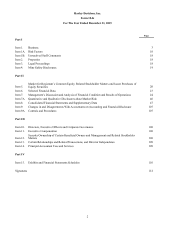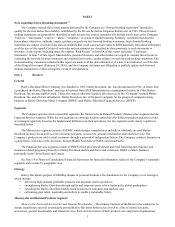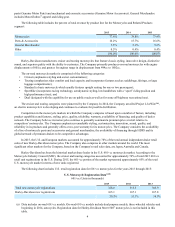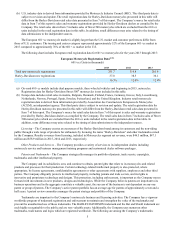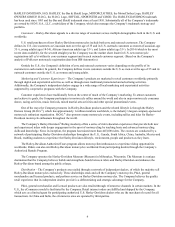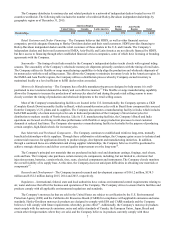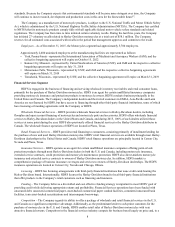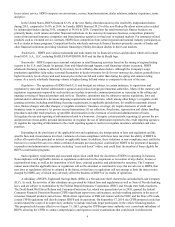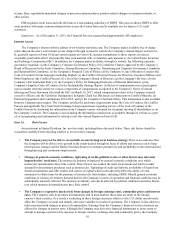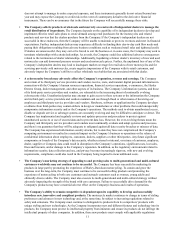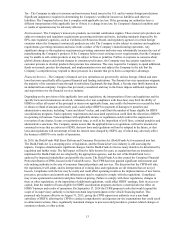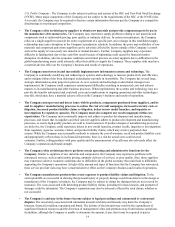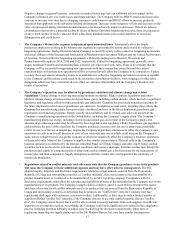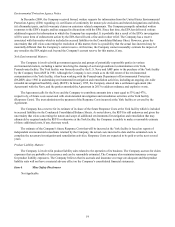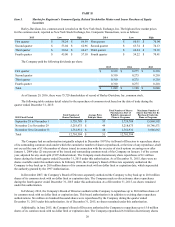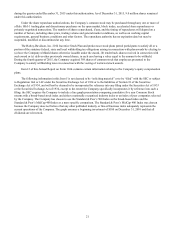Harley Davidson 2015 Annual Report Download - page 12
Download and view the complete annual report
Please find page 12 of the 2015 Harley Davidson annual report below. You can navigate through the pages in the report by either clicking on the pages listed below, or by using the keyword search tool below to find specific information within the annual report.12
worldwide and satisfy the potential demand for products that produce lower emissions and achieve better fuel
economy. The Company must make product advancements while maintaining the classic look, sound and feel
associated with Harley-Davidson products. The Company must also be able to design and manufacture these products
and deliver them to a global marketplace in an efficient and timely manner. There can be no assurances that the
Company will be successful in these endeavors or that existing and prospective customers will like or want the
Company’s new products.
• Expanding international sales and operations subjects the Company to risks that may have a material adverse
effect on its business. Expanding international sales and operations is a part of the Company’s long-term business
strategy. To support that strategy, the Company must increase its presence outside the U.S., including additional
employees and investment in business infrastructure and operations. International operations and sales are subject to
various risks, including political and economic instability, local labor market conditions, the imposition of foreign
tariffs and other trade barriers, the impact of foreign government laws and regulations and U.S. laws and regulations
that apply to international operations, and the effects of income and withholding taxes, governmental expropriation
and differences in business practices. The Company may incur increased costs and experience delays or disruptions in
product deliveries and payments in connection with international operations and sales that could cause loss of
revenues and earnings. Unfavorable changes in the political, regulatory and business climate could have a material
adverse effect on the Company’s net sales, financial condition, profitability or cash flows. Violations of laws that apply
to the Company's foreign operations, such as the U.S. Foreign Corrupt Practices Act, could result in severe criminal or
civil sanctions, could disrupt the Company's business and result in an adverse effect on the Company's reputation,
business and results of operations.
• Retail sales of the Company's independent dealers may be impacted by weather. The Company has observed that
abnormally cold and/or wet conditions in a region could have the effect of reducing demand or changing the timing for
purchases of new Harley-Davidson motorcycles. Reduced demand for new Harley-Davidson motorcycles ultimately
leads to reduced shipments by the Company.
• Retail sales of new motorcycles by the Company’s independent dealers may be adversely impacted by increased
supply of and/or declining prices for used motorcycles and excess supply of new motorcycles. The Company has
observed that when prices for used Harley-Davidson motorcycles have declined, it can have the effect of reducing
demand among retail purchasers for new Harley-Davidson motorcycles (at or near manufacturer’s suggested retail
prices). Further, the Company and its independent dealers can and do take actions that influence the markets for new
and used motorcycles. For example, introduction of new motorcycle models with significantly different functionality,
technology or other customer satisfiers can result in increased supply of used motorcycles, and a decrease in the
inventory of used motorcycles available for sale at Harley-Davidson dealers in the U.S. may result in an increased
supply or decreased demand in the market for used Harley-Davidson-branded motorcycles, which could result in
declining prices for used motorcycles, and prior model-year new motorcycles. Also, while the Company has taken
steps designed to balance production volumes for its new motorcycles with demand, those steps may not be effective,
or the Company’s competitors could choose to supply new motorcycles to the market in excess of demand at reduced
prices which could also have the effect of reducing demand for new Harley-Davidson motorcycles (at or near
manufacturer’s suggested retail prices). Ultimately, reduced demand among retail purchasers for new Harley-Davidson
motorcycles leads to reduced shipments by the Company.
• The Company must comply with governmental laws and regulations that are subject to change and involve
significant costs. The Company’s sales and operations in areas outside the U.S. may be subject to foreign laws,
regulations and the legal systems of foreign courts or tribunals. These laws and policies governing operations of
foreign-based companies may result in increased costs or restrictions on the ability of the Company to sell its products
in certain countries. The Company’s international sales operations may also be adversely affected by U.S. laws
affecting foreign trade and taxation.
The Company’s domestic sales and operations are subject to governmental policies and regulatory actions of agencies
of the United States Government, including the Environmental Protection Agency (EPA), SEC, National Highway
Traffic Safety Administration, Department of Labor and Federal Trade Commission. In addition, the Company’s sales
and operations are also subject to laws and actions of state legislatures and other local regulators, including dealer
statutes and licensing laws. Changes in regulations or the imposition of additional regulations may have a material
adverse effect on the Company’s business and results of operations.


